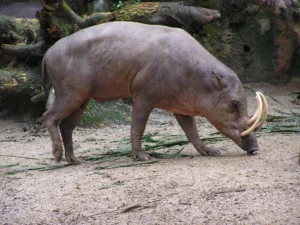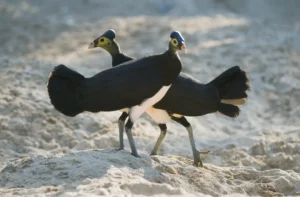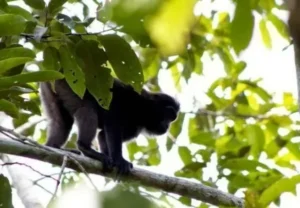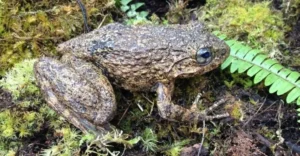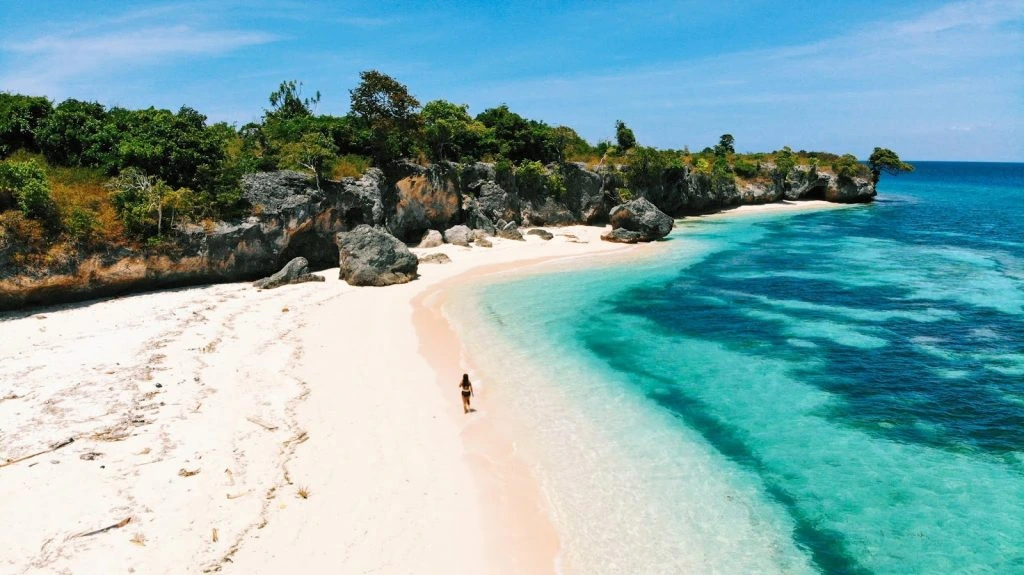Sulawesi, a majestic island in Indonesia, holds unparalleled biological richness, especially regarding the Indigenous Fauna of Sulawesi. Its natural wonders are reflected not only in the beauty of its landscape but also in the exceptional diversity of its fauna. The island is home to a variety of endemic animal species found nowhere else in the world. The Indigenous Fauna of Sulawesi is the distinctive hallmark of the exceptional nature of this island, creating a unique and precious ecosystem.
In this article, we will explore the beauty and uniqueness of 12 species of the Indigenous Fauna of Sulawesi that deserve to be known. From the adorable tarsier to the robust anoa, each species has a story and plays a crucial role in the Sulawesi ecosystem. By understanding this biological diversity more deeply, we can reflect on the importance of protecting each species and its habitat. By understanding and appreciating the diversity of the Indigenous Fauna of Sulawesi, we can play an active role in preserving this amazing ecosystem, ensuring that its biological richness endures for future generations.
12 Species of the Indigenous Fauna of Sulawesi
1.Sulawesi Tarsier
Source: indonesia.travel
The Indigenous Fauna of Sulawesi, particularly the presence of the Sulawesi tarsier, plays a central role in building the island’s biodiversity. The Sulawesi tarsier, the world’s smallest primate, creates a unique attraction for nature lovers who want to experience the wonders of Sulawesi’s nocturnal forests. With its large eyes adapted for night vision and striking ears, this primate is a sign of the abundance of nocturnal life in its ecosystem.
The presence of the Sulawesi tarsier is not only a fascinating natural phenomenon but also the primary focal point of conservation efforts for the Indigenous Fauna of Sulawesi. As an endemic species, the Sulawesi tarsier faces serious threats, particularly deforestation and illegal hunting. Ongoing conservation efforts aim to ensure the survival of this primate, and their success will have positive effects on the entire ecosystem. By focusing on awareness of the Indigenous Fauna of Sulawesi, especially the protection of the Sulawesi tarsier, we can ensure that the beauty and uniqueness of Sulawesi’s nature are preserved for future generations.
2.Sulawesi Babirusa
Source: activewild.com
The Sulawesi babirusa, also known as the Celebes babirusa, is one of the wonders of the Indigenous Fauna of Sulawesi that captures the attention of researchers and nature enthusiasts. The uniqueness of this animal lies in its curved tusks, distinguishing it from other types of babirusa. This animal is a symbol of the island’s biodiversity and is a major attraction for nature lovers who want to experience the presence of Sulawesi’s endemic fauna.
The Sulawesi babirusa inhabits the forests of Sulawesi, especially in mountainous regions. Its presence not only enriches the natural beauty of the island but also plays a key role in maintaining the balance of the ecosystem. As an herbivore, it contributes to the nutrient cycle in the forest and influences vegetation, thus maintaining the sustainability of nature. However, like many other species of the Indigenous Fauna of Sulawesi, the Sulawesi babirusa faces serious pressure from illegal hunting and habitat loss caused by human activities.
The conservation of the Sulawesi babirusa is extremely important to ensure the sustainability of this species. Protecting its natural habitat, monitoring illegal hunting, and increased awareness of the importance of biodiversity can be strategic measures to ensure the survival of the Sulawesi babirusa and preserve the unique natural heritage of the island. By focusing on the Indigenous Fauna of Sulawesi, including the Sulawesi babirusa, we can build a solid foundation for the preservation and sustainability of the environment on this charming island.
3.Anoa
Source: daftar-fauna.blogspot.com
The anoa, an exclusive herbivorous mammal of Sulawesi, contributes significantly to the richness of its ecosystem. There are two types of anoa on this island, namely the lowland anoa and the mountain anoa, both playing an essential role in maintaining the natural balance. The lowland anoa tends to live in vast plains, while the mountain anoa is more often found in steep mountainous regions.
Although they play an important role in the ecosystem, anoa face serious threats, especially hunting and habitat loss. Due to their vulnerable status, anoa protection is an urgent necessity. Illegal anoa hunting is primarily related to the demand for meat and their horns, considered trophies. Additionally, habitat destruction due to human activities such as deforestation and encroachment into wild areas contributes to the decline in anoa populations.
Anoa conservation involves a holistic approach that combines habitat preservation, strict monitoring of illegal hunting, and raising public awareness about the importance of these magnificent creatures. By understanding the positive impact of anoa on the Sulawesi ecosystem, conservation efforts can be intensified to ensure these unique animals continue to thrive on this Indonesian island. The Indigenous Fauna of Sulawesi, including anoa, is a source of pride and admiration for the inhabitants and visitors of the island, and its preservation is crucial for the sustainability of Sulawesi’s unique ecosystem.
4.Maleo
Source: iucnsos.org
The Indigenous Fauna of Sulawesi, especially endemic birds like the Maleo, enriches the biodiversity of this island with its uniqueness and exceptional reproductive strategy. The Maleo, with its unique method of egg dispersal, digs holes in volcanic soil and uses geothermal heat to hatch its eggs. This method not only demonstrates exceptional adaptation to the environment but also creates its own appeal for nature lovers and researchers.
While this uniqueness is one of the distinctive features of the Indigenous Fauna of Sulawesi, the Maleo faces serious challenges threatening its sustainability. Habitat loss due to deforestation and climate change has reduced the space needed for the Maleo to reproduce. Additionally, illegal hunting poses a direct threat to the population of these birds. Therefore, Maleo conservation is a major priority to ensure its survival.
Conservation efforts involving habitat preservation, law enforcement against illegal hunting, and public education are essential to preserve the sustainability of the Indigenous Fauna of Sulawesi, including unique species like the Maleo. Thus, together, we can preserve the captivating biodiversity of the island of Sulawesi for future generations.
5.Sulawesi Kuskus
Source: fineartamerica.com
The Sulawesi kuskus, a small marsupial inhabiting the trees of Sulawesi’s forests, offers a spectacular view and is an integral part of the diversity of the Indigenous Fauna of Sulawesi. With its soft fur and long tail, this kuskus is not only a sign of diversity but also creates its own attraction for nature observers and wildlife enthusiasts. The Sulawesi kuskus lives endemically on this island, and their protection is essential to maintaining the sustainability of the ecosystem.
Conservation efforts are essential to protect the home and maintain the stability of the Sulawesi kuskus population. Threats to their survival include habitat destruction due to deforestation and climate change. Therefore, forest preservation measures and environmental rehabilitation efforts are crucial. Additionally, educating the population about the importance of maintaining ecosystem balance and protecting the Indigenous Fauna of Sulawesi, including the Sulawesi kuskus, can contribute significantly to the success of conservation initiatives.
By highlighting the importance of the Sulawesi kuskus, we emphasize the need to preserve the unique and captivating features of Sulawesi’s biodiversity. As a distinctive member of the Indigenous Fauna of Sulawesi, the Sulawesi kuskus contributes to the charm and magic of the island’s nature. Through concerted efforts to protect its habitat and raise awareness about its significance, we can ensure that the Sulawesi kuskus continues to enchant nature lovers and researchers alike.
6.Sulawesi Crested Macaque
source: 1001indonesia.net
The Sulawesi Crested Macaque, also known as the black monkey of Sulawesi, is one of the large primates that attracts attention in the northern region of Sulawesi. Their popularity is determined not only by their large size but also by the unique color of their fur, adding a distinctive feature to the richness of the Indigenous Fauna of Sulawesi. Although they are in the spotlight, the Sulawesi Crested Macaque faces serious threats that can affect their survival, namely habitat loss and illegal hunting.
The threats to the Sulawesi Crested Macaque involve the loss of their natural habitat due to deforestation and land conversion. Illegal hunting for the pet trade and commercial exploitation also pose a serious threat to the population of the Sulawesi Crested Macaque. Therefore, it is important to increase public awareness of the importance of protecting this species and to support conservation efforts aimed at preserving their natural habitat.
Through educational campaigns, strict enforcement of laws against illegal hunting, and habitat preservation efforts, we can play a role in protecting the Sulawesi Crested Macaque and ensure that this primate can continue to thrive in its natural environment. By increasing awareness of the threats facing the Sulawesi Crested Macaque, we can encourage concrete measures to preserve the diversity of the Indigenous Fauna of Sulawesi and ensure that the macaque remains an inseparable part of the beauty of this island.
7.Gorontalo Monkey
source: faunadanflora.com
The Gorontalo Monkey, one of the distinctive and endemic primate species in the Gorontalo region of Sulawesi, attracts the attention of researchers and nature lovers. As an integral part of the Indigenous Fauna of Sulawesi, this monkey contributes significantly to the biodiversity of the island. With its colorful fur and interesting social behavior, the Gorontalo Monkey creates a charming view in the forests of Sulawesi.
The Gorontalo Monkey lives in the Gorontalo region with a unique ecology, including mountain forests and lowland plains. As a primate exclusively found in Sulawesi, the survival of the Gorontalo Monkey also depends on the sustainability of its natural habitat. Threats such as deforestation, illegal hunting, and conflicts with humans are challenges to be addressed in conservation efforts for the Gorontalo Monkey and the Indigenous Fauna of Sulawesi as a whole.
Through targeted conservation efforts, scientific research, and community awareness, we can collaborate to ensure that the Gorontalo Monkey remains an indispensable part of the captivating natural richness of Sulawesi.
8.Sulawesi Cockatoo
source: hargamerek.com
The Sulawesi Cockatoo, or Banggai Cockatoo, is one of the wonders of the Indigenous Fauna of Sulawesi highly sought after in the world of exotic birds. Their uniqueness and the beauty of their colorful feathers make them a major attraction for bird collectors and wildlife enthusiasts. Spread across various regions of Sulawesi, the Sulawesi Cockatoo plays an essential role in maintaining the diversity of this island.
However, the sustainability of the Sulawesi Cockatoo faces serious challenges. Illegal trade is a major threat, where these birds are often hunted to meet the demand of the international market. Habitat loss due to deforestation and climate change also poses a significant threat to the survival of the Sulawesi Cockatoo.
Therefore, conservation measures involving the preservation of natural habitats, strict enforcement of laws against illegal trade, and public awareness campaigns are extremely important to ensure that the Sulawesi Cockatoo remains a pride of the Indigenous Fauna of Sulawesi. By involving all stakeholders, we can together ensure the sustainability and diversity of the Indigenous Fauna of Sulawesi, including this fascinating Sulawesi Cockatoo.
9.Sulawesi Red-Knobbed Hornbill
Source: mongabay.co.id
The Sulawesi red-knobbed hornbill, a magnificent bird species, contributes to the vibrancy of the Indigenous Fauna of Sulawesi. Known for its striking appearance, characterized by a large casque on its bill and vibrant colors, this hornbill is a symbol of the island’s rich biodiversity. With its unique features and behaviors, the Sulawesi red-knobbed hornbill is a source of fascination for bird enthusiasts and researchers alike.
However, like many other species of the Indigenous Fauna of Sulawesi, the Sulawesi red-knobbed hornbill faces threats to its survival. Habitat loss due to deforestation and illegal pet trade are significant challenges that impact the populations of this bird species. Conservation efforts are crucial to ensuring the protection and sustainability of the Sulawesi red-knobbed hornbill. Measures such as habitat preservation, strict regulations against the illegal pet trade, and public education can contribute to the successful conservation of this unique hornbill.
By focusing on the Sulawesi red-knobbed hornbill, we shed light on the importance of preserving the diverse avian species within the Indigenous Fauna of Sulawesi. Each species, whether mammal, reptile, or bird, plays a crucial role in maintaining the balance of the ecosystem. Through collective efforts and a commitment to conservation, we can ensure that the Sulawesi red-knobbed hornbill and other unique species continue to thrive in their natural habitat.
10.Sulawesi Bats
source: klikhijau.com
Sulawesi, as a biodiverse-rich island, is home to various species of bats, some of which can only be found on this island. Bats, as an integral part of the Indigenous Fauna of Sulawesi, play a crucial role in maintaining ecosystem balance, especially by controlling insect populations. With a diet consisting of various insects, bats help support nature by reducing the number of insects that can harm plants and vegetation.
However, the sustainability of bats in Sulawesi faces serious threats. Habitat changes due to deforestation and urban growth can reduce their living space. Conflicts with humans also pose a problem, especially when bats enter establishments in search of food. Additionally, negative perceptions of bats often lead to harmful eradication actions against their populations. Targeted conservation efforts are needed to protect the sustainability of bats in Sulawesi.
This includes preserving natural habitats, community awareness campaigns about the crucial role of bats in the ecosystem, and developing strategies to reduce conflicts with humans. By maintaining the sustainability of bats, we can ensure that their ecological functions continue to work properly, supporting natural balance and preserving the richness of the Indigenous Fauna of Sulawesi.
11.Sulawesi Hornbill
source: ebird.org
The Sulawesi Hornbill, as an integral part of the Indigenous Fauna of Sulawesi, adds a special charm to the biodiversity of this island. The Sulawesi Hornbill, with its long beak and striking feather colors, plays a vital role in Sulawesi’s ecosystem. They are accustomed to eating fruits and nectar, making them natural pollinators and helping maintain the sustainability of plants and vegetation on the island. Despite their significant ecological role, the Sulawesi Hornbill faces serious challenges, especially related to habitat loss and illegal hunting.
Deforestation and land-use changes can harm their living spaces, while illegal hunting threatens the sustainability of their population. Therefore, preservation efforts focused on preserving natural habitat, monitoring human activities that degrade it, and strict enforcement of laws against illegal hunting are essential to protect the Sulawesi Hornbill.
Through these conservation measures, we can collectively ensure that the Sulawesi Hornbill remains a valuable part of the richness of the Indigenous Fauna of Sulawesi. By raising awareness in the community about the importance of protecting this species, we can ensure that the beauty of nature and biodiversity on the island of Sulawesi are preserved for future generations.
12.Sulawesi Spotted Frog
source: bernas.id
The Sulawesi Spotted Frog, with its striking colorful patterns and as an endemic amphibian of this island, presents unique natural beauty in the forests of Sulawesi. Despite their small size, the crucial role played by the Sulawesi Spotted Frog in the food chain and ecosystem health makes it an indispensable species. This frog has the ability to capture and consume insects, helping control insect populations that can harm plants and vegetation around them.
However, the Sulawesi Spotted Frog faces threats mainly related to habitat loss and environmental changes. Human activities, such as deforestation and land-use changes, can harm their habitat. Therefore, protecting the natural habitat of the Sulawesi Spotted Frog is crucial to maintaining the sustainability of this species.
Preservation efforts involving forest conservation, reducing the impact of human activities, and increasing community awareness of the importance of amphibian ecosystems can help ensure that the Sulawesi Spotted Frog remains an integral part of the richness of the Indigenous Fauna of Sulawesi. By making these preservation efforts, we can address conservation challenges and ensure that Sulawesi’s biodiversity remains preserved, including the beauty brought by the Sulawesi Spotted Frog in the amazing forest environment.
Conclusion
Sulawesi, the majestic island of Indonesia, exhibits extraordinary biological richness, especially in its indigenous fauna. With captivating natural beauty, Sulawesi is home to various species of endemic fauna found nowhere else in the world. This biodiversity serves as a marker of the island’s natural uniqueness, creating a unique and precious ecosystem.
Conservation efforts are essential to ensure the sustainability of these species. Protecting natural habitats, enforcing laws against illegal hunting, and increasing community awareness of the importance of biodiversity can help ensure that Sulawesi’s natural beauty remains sustainable.
By understanding and appreciating the diversity of the Indigenous Fauna of Sulawesi, we can actively contribute to maintaining the sustainability of this amazing ecosystem, providing a precious natural legacy for future generations. Plan your trip to Sulawesi with Salut Bali to directly observe the beauty of nature with the Indigenous Fauna of Sulawesi. We are ready to accompany you on your journey to the island of Sulawesi. Contact us now!



